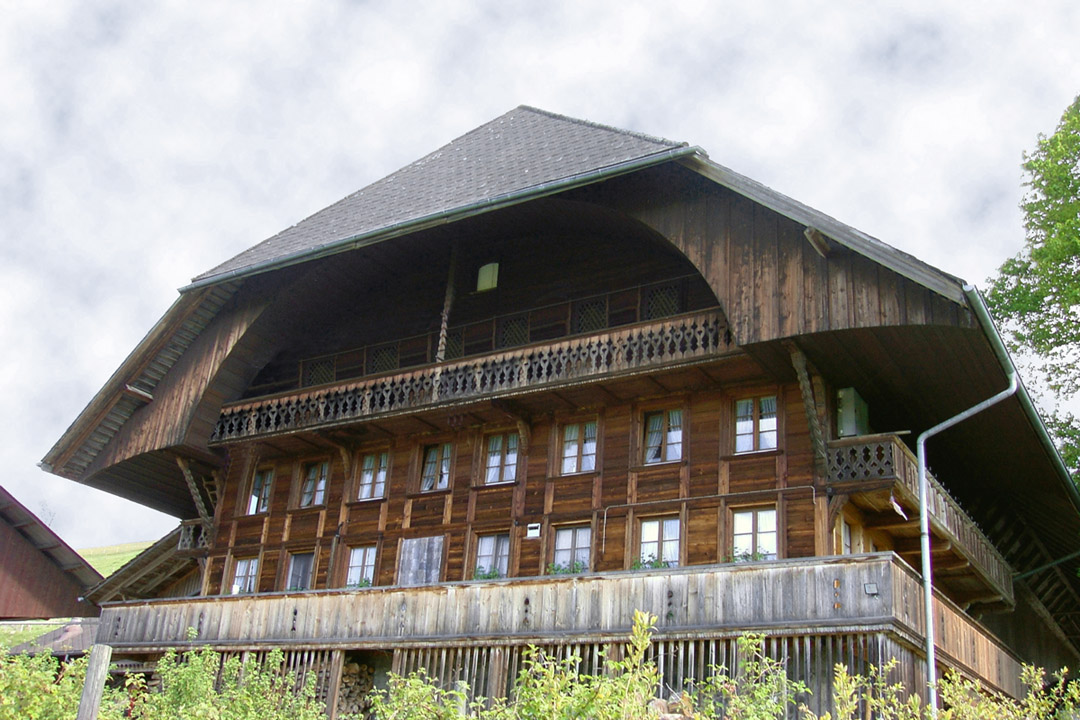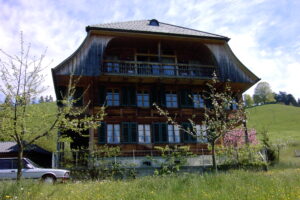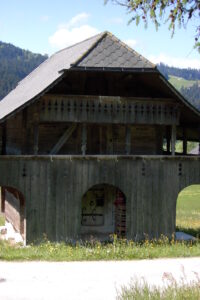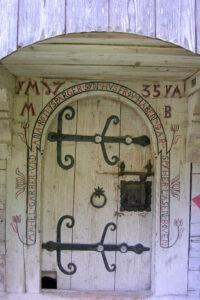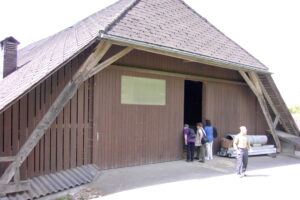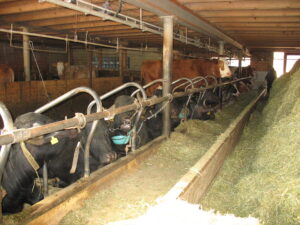Introduction
There has been much intrigue regarding the farm called “Giebel”, or “Gibel”. Giebel is actually a family of farms that consists of the following farm names:
- Vorder Giebel
- Mittler Giebel
- Hinter Giebel
- Giebelmoos
- Giebelfeld
- Giebelkellen
- Giebelhohe
- Giebelgräbli
Various spellings of the above houses have been used over the years. The term, “Giebel”, simply means “gable” in English. The prefixes and suffixes often denote the location or position of each house relative of the others, and sometimes they denote the type of land on which the farm sits.
This page is dedicated to the house named “Vorder Giebel” due to its interesting history. If you have questions regarding any of the other houses, please feel free to ask your questions through this website.
Location
The Giebel farms are located just east of Langnau im Emmental, Canton Bern, Switzerland. They are actually located north of a town called “Bärau”. The Ilfis river runs just south of the farms. The southern sides of the houses face the tallest peaks of the Swiss Alps. The farms cascade down the hillside to the north. The houses are located on a hillside known as Giebel. It was thought that the houses were named “Giebel” due to the prominent “gables” on the houses, but all Emmental farmhouses share that feature. Rather, the plateau at the top of the hill on which these farms are located is in the shape of a “gable”. Therefore, it is suspected the houses are named after the landscape, not the architecture.
Construction
The houses on the farms have been rebuilt over the years. However, they have kept the traditional Bernese appearance for which this area is renown. There are large balconies on the fronts and sides of the houses which are lined with flower boxes creating a colorful appearance during the Spring, Summer, and Autumn seasons. Often, the houses have gardens to the front. The interiors of these houses are normally updated to current building standards and typical European styles. Some of these Bernese houses, including Vorder Giebel, are built into the hillside.
Most of these farms raise dairy cows. As it is with Vorder Giebel, some of these houses have an area beneath the main living quarters where the cows are fed and milked. The cattle can be brought into that feeding room through side doors. There often is a large barn door on the back of the main house that opens to a hay loft. Hay can then be dropped down into the area where the cows are milked.
There are normally storage and livestock barns on the premises. Additionally, you may see a spiecher (spycher) which is a small storage shed that was commonly added centuries ago. At Vorder Giebel, you will find an inscription around the front door on the first floor of its spiecher that indicates Michael Gerber and his wife, Anna Röthlisberger, built the building in 1734. At Giebel, the speicher was once larger with a outer wall encompassing the building’s first floor.
An additional building, called a “stöckli”, is often located on premises. This building is most often used as a retirement home for the parents when they pass the farm down to the youngest male child. That child is then obligated to provide for the parents in their retirement. At Vorder Giebel, the main living area of the stöckli was also used as a meeting place for a new church in the area which later moved to its own building down the road. More will be explained about the church under the History section.
History
The houses throughout Emmental region have long and various histories. This section is devoted to the history of Vorder Giebel. The exact date of first construction in the area is unknown. When mentioning Giebel, most early documents do not delineate specific farms. Therefore, it is difficult to know who inhabited which house. There was an early mention of Giebel (or Gibel) in a book published in 1976 called “Ortsnamenbuch Des Kantons Bern” by Paul Zinsli which records a 1297 reference for the area of Giebel near Langnau as “Ghibuln”. So, we know that the location of Giebel was well-known and likely populated from very long ago. In that book, you will find many early spellings of Giebel, such as “Gibell”, “Ghibuln”, “Giblen”, “Gybel”, etc. Most earlier references to the house use the spelling “Gibel”. In the 1800’s, it was more often spelled as “Giebel”. More recently, the spelling has reverted on many maps to “Gibel” again.
As far as Vorder Giebel is concerned, we can definitively trace the ownership into the late 1600’s when it was owned by Hans Bürki. Hans had a very large family and was considered an Anabaptist elder and teacher. During the height of Anabaptist persecution, the area of Langnau was an area where the persecution was most concentrated, and Hans found himself a victim of the persecution which was likely the main reason he sold the farm.
This website will not attempt to give a complete history of Anabaptism, but it is worthwhile understanding a little about their beliefs and their plight. The Anabaptist movement had very early origins, but no one knows for sure where it began. Some claim that it began with the Waldensians, who trace their origins back to the 12th century, because they share many common views. The Waldensians desired to work with the Catholic church, not separate from it. However, the Pope at the time would not allow it and began to persecute them. The followers were forced to practice the faith largely in secret. The mountainous regions were often the easiest areas to practice non-conforming religious views. It is thought that many of the Waldensian views persisted throughout the centuries and found fertile ground in the minds and hearts of the Swiss inhabitants. Once the Reformation began and the Bible was more readily available to be read by commoners, many groups in Europe began to possess views that did not conform entirely with Catholicism. The people in the mountainous regions of Switzerland may have taken this opportunity to modify their secret beliefs even further which could have developed into what is now known as Anabaptism.
Ulrich Zwingli, a contemporary with Martin Luther in Germany, began a Protestant movement in Switzerland in the first half of the 1500’s. He sought to reform a few Catholic practices when establishing his church movement which would ultimately be known as the Swiss Reformed Church. However, there were a group of individuals attending some of the early meetings that did not feel Zwingli went far enough in his beliefs. Zwingli seemed to be receptive of some of these reforms, but he did not feel society was ready to embrace them. This group of “rebels” appear to have sown the seeds of rebellion that officially launched the Anabaptism movement.
So, it is likely that Anabaptism formed from the ongoing rejection of the long-held beliefs of the Waldensian-minded individuals who were seeking reform in Switzerland. This rejection culminated during the early phases of the Reformation Movement when these views were not accepted as a recognized church in Switzerland. In a way, Anabaptism beliefs were too premature for society to adopt. Ironically, they were considered too radical for their time.
The leaders in Switzerland had to make a decision during the Reformation. They did not wish to allow everyone to practice their non-conforming beliefs, but they also recognized that religious change was not preventable. Catholicism and the European governments had worked together to control the populous, and both parties feared losing control. Some ways to control the populous was through baptism, marriage, and death records (Rodels) that were required to be kept by the churches. These records gave the governments a way of knowing the status of their citizenry, and it allowed them to keep a standing army made up of their citizens. In Switzerland, each male was armed and was to be available to fight for the country if called upon. Taxes were also collected through the church. If people did not attend church, control would be lost. The Catholic church would receive certain favors from the government for their mandated “cooperation”. So, it was largely a co-dependent relationship. The Swiss government developed a unique solution to encourage attendance in an environment of ever-increasing desire by individuals to separate from the Catholic church. Each canton (similar to a US state) was required to choose which religion would be allowed in their canton (Catholicism or Swiss Reformed as the only options). So, only one church denomination was allowed in each area. This state-sponsored church system eventually caused cantons to be unfriendly toward each other.
If a person held differing views from their official canton’s recognized church, he or she would be out-of-luck. However, that did not mean people didn’t still exercise their belief system despite being part of a rogue church. What were some of the beliefs of the Anabaptists? Essentially, they took Jesus’ “Sermon on the Mount” quite literally as you will see in the list below. As with most church movements, there are always some differences in opinions on some issues, but some of the main tenants of Anabaptism are the following:
- Baptism should be done once the person had chosen to be part of the church, not as an infant. This practice is often known as “believers baptism”. Their reasoning was that infant baptism was not a practice seen in the Bible.
- While governments had the responsibility and God-given right to fight for a righteous cause, Jesus had given his believers the instruction to “turn the other cheek”. To them, bearing arms for purpose of fighting was not scriptural. Therefore, they rejected Switzerland’s requirement that they be part of the country’s army. Many would volunteer, however, to serve as medics.
- Swearing an oath was forbidden. Jesus instructed that individuals should refrain from swearing an oath, but rather be people who keep to their word at all times, letting their “yes” be “yes” and “no” be “no”.
- They should refrain from taking people from court. Rather, they were to work out differences between each other.
- Keeping “Mass” was not a requirement. Rather, a personal relationship with God was stressed. The system of a priesthood was considered non-Biblical. As such, they often gathered in each other’s houses once every two weeks to study scripture together. There were no paid clergy members, but there were individuals considered as church leaders. Sometimes, this rejection of “Mass” was because a large gathering of Anabaptists was prohibited by the government during the times when it was tolerated.
- The practice of “shunning” was used to correct an individual’s behavior within the church. This practice was carried to the extreme by some groups, but it wasn’t a focus for the churches in Langnau. The Amish factions seemed to utilize it the most.
- Caring for the poor within the church was an essential practice, and money was collected from church members to put into a fund to care for the unfortunate. An church-office was established in each community to carry out these functions.
- Missionary efforts were very common.
The persecution of Anabaptists in Switzerland is a topic that is too lengthy to discuss in detail here. However, I will give a brief overview. Much of the persecution in Switzerland was centered in the canton of Bern, the second largest canton in Switzerland. Because neighboring cantons often held different religious views, conflicts arose between those cantons. The last thing the canton of Bern needed was to fight battles from within. The officials thought initially that it would be easy to quash a threat from the relatively small religious group, but they were very wrong. It seemed the more actively they pursued persecution, the larger the Anabaptist group became. They tried hanging people in cages or baskets from a church tower, execution by various means including drowning and sword, torture methods to get them to denounce their views, sending them to the Venetian gallows to row their ships, levying taxes, expulsion from their land, forced emigration.
Throughout the years, many Anabaptists left Switzerland, usually in waves that coincided with newly-instituted laws. At first, they would find relative security in other areas of Europe while still being subjected to many difficulties. Such areas included cantons that tolerated them more as well as the area in the northern portion of the canton of Bern meets France and Germany in the mountains of the Jura. Some fled to Austria or the Palatinate of Germany. In these areas, they were tolerated for a time, but the land they were given was the land no one else wanted. They were forced to rent the land from the locals. However, they worked hard and brought innovation that allowed them to thrive even in difficult environments. Usually, locals resented these Anabaptists being able to compete with them economically. So, they often appealed to the kings and other leaders who controlled the land. Eventually, most of these Anabaptists left, often fleeing to America in order to avoid causing too much confrontation.
The Swiss government formed their own group of mercenaries to find Anabaptists. They utilized church officials to find and report where the Anabaptists were living. The privilege of being the only sanctioned church in a canton meant you had to comply with demands of the government. However, finding these Anabaptists was a difficult task for many reasons. First, most people seemed sympathetic to the neighbors. Anabaptists were known to be spiritually devout individuals who were recognized as very hard workers. Anabaptists didn’t like to cause problems and attempted to work out their differences without going to court. They paid their fees and taxes. Additionally, many people who were members of the State church were secretly members of the Anabaptists churches (they were called Halb-Täufers). Many Anabaptists spent the summers in the higher regions of the alps where the grass developed later in the season making the land good grazing ground. The land owners in those areas sold rights to dairy farmers to utilize their pastures in the summer, and small huts were provided for many of these workers to utilize as temporary houses. These individuals or families did not frequently attend church services during those periods, so it was very difficult for the church to know if someone was absent due to their beliefs or because they were working elsewhere.
Eventually, the factions of Anabaptists formed into what we know in the United States as Mennonites, Amish, Hutterites, Apostolic Christian Church, etc. One of the most complete books that explains Swiss Anabaptist history is called “Bernese Anabaptists And Their American Descendants” by Delbert L. Gratz. It compiles much of what I have learned from him, other historians, family members, and from family records.
This leads us back to Hans Bürki, the owner of Giebel prior to 1731. Hans was an Anabaptist minister and had been arrested and removed from his land more than once. One time, he was shipped up the river on a boat carrying Anabaptists who were bound for the “Carolinas”. After being captured, he would either escape or be told that he was not legally allowed to return to his homeland. However, he found his way back a few times. His wife was allowed to purchase the farm, with a stiff penalty, so that it could be kept in the family even in his absence, but there was a lot of debt owed on it. Eventually, the family sold the farm either so they could rejoin their husband and father, or because they were forced to sell it since their debt had increased substantially. Much has been written about Hans that can be found on numerous websites as well as in many books. A very condensed history can be found at this website:
https://talesofourpast.com/hans-burki-a-story-of-persecution-and-perserverance/
Michael Gerber (Michel) and his wife, Anna Röthlisberger, purchased Vorder Giebel from the wife of Hans in 1731. He likely would not have been allowed to purchase the farm if he openly practiced their beliefs. However, both Michael and his father, Christian, had loaned money to Hans at the time of the purchase of the farm. Michael also had three sons who appear to have been Anabaptist: Christian, Johannes (Hans), and Niklaus. There is some evidence that Christian was banished from his land and that Niklaus was also removed for a time. While there is no direct evidence that Michael was an Anabaptist himself, it appears that he was either sympathetic to their beliefs or he could have been a Halb-Täufer himself.
Michael’s youngest son, Niklaus, received the farm as his inheritance. Niklaus transferred Giebel to his youngest son, Christian, from his first wife. Before his death, Niklaus purchased other farms for his other two boys: Michael and Niklaus.
Christian was a extremely well-respected Anabaptist minister. He was referred to as “Christeli” in order to differentiate him from his well-known grandson by the same name. Christian became discontent with the Anabaptist church in Langnau feeling that they had become too passive in their practices and that they did not act spirit-filled. Christian became acquainted with Samuel Fröhlich, a person who had been an ordained minister in the Swiss Reformed Church but who had been removed from his office in 1831 due to some disagreements. Froehlich’s beliefs aligned themselves closely to Anabaptist beliefs. Christian split a group of individuals off from the Anabaptist church and began to proselytize mostly individuals from the Swiss Reformed Church. This new movement was known as the “Neutäufer”, meaning “new baptism”. Anabaptists around Langnau were originally referred to as “Mennonite” or “Wiedertäufer”, but began to be known as “Alttäufer” following the split in the church. Eventually, members of the Neutäufer movement would immigrate into America and form what is known as the Apostolic Christian Churches of America. In Switzerland, they are known as the “Evangelischer Täufergemeinde” or ETG for short.
Christian had ten children, but did not pass Vorder Giebel down to his youngest son, Matthys, because the son was handicapped and deemed not capable of caring for the farm. Rather, he passed it down to his son, Niklaus. Not much is known of Niklaus. We know he had at least one son, but we do not know of any other children. His son, Christian, received the farm.
Christian became very wealthy, likely because he received nearly all, if not all, of his father’s inheritance. He was known to be very generous and had become the person in charge of caring for the poor in the area. He built the Stöckli, a residential house to the west of the main house. This house would receive the parents when they passed down the farm to their child. That child, usually the youngest male child, would then be responsible for caring for the parents. It was in this Stöckli that the early Neutäufer church often met. His wife was Anna Barbara Gerber whose family came out of the farm called “Baumgarten”. It is also suspected that Christian’s ancestors also came from that farm nearly two centuries earlier. Anna Barbara was very well respected as she was known as a woman who didn’t mind hard work, even work that was normally reserved for men. Many more farms and lands were purchased by this couple for their children.
Christian passed the farm down to his son, Ulrich. The farm has since been passed down to the youngest male child over the next three generations.
Peter Gerber, a direct descendant of the Giebel owners and a distant cousin of this author, has compiled a history of Giebel with much more detail than what is listed on this webpage. It also briefly takes a detour to show how his family is connected with the Giebel owners. If you desire to know more, …Additional information can be found at the individual pages on this website.
